Subscribe now to get notified about IU Jharkhand journal updates!
An Empirical Study on Agile Project Management in IT Company
Abstract :
In project management, and in predominantly software project management, there is a move since old-style plan-based project management to the agile event focused project management style. Agile project management is observed as the new immense alteration and has a major impact on software industry. It can be definitely thought that the agile is fetching the new standard for software development projects. The notion of agile is about for some period, and though knowledge and procedure are growing, agile is not constantly the solution. Accepting at what time to practice agile and which accomplishment aspects are to be measured is vital for organizational achievement. Agile is quite prevalent and new methodologies keeps performing. The main goal of this research is to find probable factors which could disturb the accomplishment of a good team environment in the industry and its relations between each of these factors. More specifically the model of the project management followed in many companies is not a stable one and hence a hybrid framework of agile project management and tools are to be studied. In this study 106 observes, which could possibly disturb the project achievement were notorious over a literature review. These practices were limited down based on the roles and experience in the industry. Finally, only certain roles had the major impact on the study and maintaining a good team environment with respect to project risk and change reaction considered as a major factor for employees’ work experience.
Keywords :
Project Management, agile, change, new standard, software development, success and project risk1. Introduction
Project management approaches have been advancedas of industry follows and international values over the years towardsguarantee a better rate of achievement for IT projects and manufacturing industries. These have been extensivelyexercised in big organizations efficiently. Still, when projects are applied in a minor or medium-sized firm setting, there is frequentlyanabsence of recognizedtechnique of project management or trained project implementers who can practice various approaches that are utilised in big organizations. As individuals working in a project discover themselves stressed to developfurtherapproachable in business strains, it is fetchingusual for minor organizations to relinquishrecognized project management procedures. This is frequently due to the circumstance that small projects are regarded as simple to deploy, suffer from anabsence of resources, or are given little prioritization by the organization. Furthermore, the present project management morals are often perceived by SMEs as complex and very undesirable in respects to time-constrained or low-budget projects. Agile development is single solution to the delinquent of excessively complex methods that has newly been accepted in the field of software production, and has expanded considerable fame with minor organizations.
This study inspects the presentcondition of formalized project management and in what way these approaches can be altered for a minor or intermediate enterprise, particularly in relation to information technology application projects. A combination of established project management approaches and fresher agile expansionapproaches were applied, with the aim of starting a grouping of the dual approaches that can support with project achievement, mainly in the instance of resource-deprivedintermediate and small sizeestablishments. The receiving of this technique by the technology workforces and shareholdersincluded was also examined. In amonetary age where organisations are mandatory to do supplementary with fewer resource, a project management procedure that can aid with effectiveapplication could showadvantageous to numerous organizations of this extent. Rising out of agile development, agile project management has excessivelatent to block this role, and it was with this aim in cognizance that this study was led.
2. Research objectives
This study is directed by the subsequent research objectives:
- To study the occurrence of a good team environment with demographic factors.
- Find out the variance between the experience of the employee and reaction to quick change in project.
- To study the relations between the importance of project management fundamental knowledge across the employees.
3. Literature Review
3.1 Agile project management:
Agile project management is a methodology in which each taskis broken down into smaller tasks and are accomplished in sessions since the initial stage to the final challengingstage as smaller tasks. These sessions are frequently called sprints, the term for iteration used in singleexact and popular agile expansion method known as Scrum (Schwaber 2004). Scrum is aoutline for project management that highlights teamwork, accountability and iterative advancement toward a distinct goal. The Scrum procedureboosts practitioners to work with what they have and repeatedly evaluate what is working and what is not working. Communication, which is ansignificant part of the process, is passed out through meetings, called Events. (Beck et al. 2001a)
3.2 The early development of project management
Project management is not a theory that has been initiated in this period. Through the eternities there have been plentifulmajor construction projects, with such actions as
the rising of the pyramids, the creation of the Stonehenge, and launch of roads and canals by the Romans (Kwak and Aanbari 2008). One of the initialtoolspresented for the direction of engineering careers was known as the Gantt chart. It was introduced by Henry Gantt and he announced the first form of this tool in the years 1910 to 1915, before the World War I.
when the war was happening, the army noticed that industries where Gantt’s technique were used had aninnovative production percentage, and then Gantt was subsequently brought in as a mentor for the upgradedmanufacture of much required war materials. The chart which was introduced by Gantt was a mainjumpfrontward in the rationalat that period, since it not only helped to directdifficult circumstances with anhonestlyeasy tool, it was also capable to be executed by aextensivevariety of individuals (Clark 1923).
Project management tools nextacknowledged a developmental enhancement as well, with the development of systems management tools such as PERT (Program Evaluation Review Technique). The preliminaryaim as a tool of PERT is to manage the method of projectilemanufacture with a bettercoarseness than theearlierimaginable. the project manager materialsestimate the maximumconstructiveperiod,utmostcynical time, and the utmostpossibleperiod. It was then intended by the mean of these estimates and it is signified by the sign μ, where the intended variance for every task is meant by the sign σ (Klastorin 2003).This tool can estimate for the time-period of each phase of the project and it is capable to be forecast and pursued, Supporting managers with aninfluentialinstrument for the process of task sequencing. The perilousway across the project is then competent to be recognized, then this will allow the project managers to realize the arrangement of jobs that will need the maximumperiod for accomplishment (Morris 1994).
3.3 IT project management in Small and medium-sized enterprises
The reputationin an SME of Information Technology has been deliberated in the priorunit, benefits and advantages of technology in such organization wasemphasized. By the thoughtfulpractice of Information Technology in an SME it will be able to increase a goodbenefit and rise the influencewhich they hold in the market. Though, in direction to increase the finestbenefit of this Information technology an SME requirement to have a thoroughprediction to support with the applicationprocedures. In this literature will be concisely inspected to found the reputation of launching a long-standing IT approach and strategy in an organization. In SME environment it isparticularlysignificant, and can support to move an organization from a responsivekind of process to a furtherpractical one. (Chell 2008; Blackman 2004). This instinctual management type may cause problemsto the SME manager. Regularly the manager will behectic with the responsibilities of directing the company with restricted supplies, that instruction is specified a compactimportance when conveyingsupplies. This decreases the invasion of innovativeconcepts, and limitsmanager from escalating the prospect of their administrativecapabilities (Tahir, Mohamad, and Hasan 2011).
In a latest paper by Turner, Ledwidth and Kelly (2010) they distinguished their interpretation, normally Austrian companies willacceptaextra autocratic method of dealwith the staffs, when related to further European countries. Though, the outcomes that Hofstede (2001) came toprove a distinct lookout. Hofstede examined the cultural alterations between people of diverse countries in his work, associating and indexing the cultural traits of countries. He distinguished that Austria as a country paradesmoderately a short power distance index. Businesses are undergoing a new information age where IT forms avital part of the infrastructure. Not only big organizations but also SMEs are able to increaseabenefit by executing IT in their business. This then raises the query, of how to expand the achievement of these IT projects in an SME setting.
3.4 The importance of SMEs, and the unique challenges they can encounter
Minor business is asignificantfragment of the economy, as approximately 99% of all industries in the European Union are characterized as an SME (CEC 2005, p. 5). The symbol of strong economy is huge SME segment, which couldaid to produce the secluded sector in developing countries (Ayyagari, Beck, and Demirguc-Kunt 2007). Smaller organization can practice some exclusiveconfronts when it originates to discover aappropriatefunding options, as these organizations prettyfrequentlyfunction with lessermoneyfunds (Thong, Yap, and Raman 1994).
Additionalproblematicin an SME is in respects to human resources.SME could absence the essential employee ability set to drive the businessfrontward, regularly due to a shortage in the monetaryfundsrequired to entice more capablelabours. There is habitually arequirement for workforces in an SME to yield on various roles, and try tasks external of their usualpart of expertise. While this mightease the delinquent of anabsence of information in the organization, it will also increase an extramonetaryproblem to the corporate (Thong, Yap, and Raman 1994). This is naturally the situation with the project management part in an SME atmosphere.
3.5 The importance of IT strategy and planning in an SME organization
The holders and managers of a businessfound that organisation with aidea of what they desire to attain. This idea is the aim of the organisation, and at the same time as it is diverse for each organisation, it might comprise such aims as maximising returns for the proprietors, offering a saferevenueto theirown family members, carryinganenergeticprovision to the community, or making a stage to establishaninnovativeknowledge into civilization. Apiece of these goals will need a technique to attain the anticipatedoutcomes, and the aim of the SME manager will perform a vibrant role in how the path and panache of the organisation’s processes are endorsed (Chell 2008; Blackman 2004). As Mintzberg (1994, p. 107) renowned, ‘Strategic preparation isn’t strategic thinking. One is study, and the supplementary is mixture.’ Whereasaoccupiedevaluation of business approach and forecasting is external the monarchy
of this literature review, it is beneficial to fleetinglydeliberate the prominentfacts of this subject, to create the connotation to IT application in an SME scenery.
3.6 The current state of IT project management in SME environments
In spite of the significance of technology to corporate, the subject of IT project let-downs has been factually a concentration point for numeroustheoretical papers and reports. Likewise, the prevalentmedia has also oftenremarked on the let-down of big IT projects. Though academics have repetitively made officialstudies regarding the scientific methods and procedures employed, these needs have been alsodisregarded or rejected by the Standish Group. This absence of academic directnessincreasesqueriesso as to the validity of the outcomes, particularly when appraised against similar academic effort that has exposedsuggestivelylesserdisappointment rates (Glass 2006b; Jørgensen and Moløkken 2006).
The last part of literature that was examinedcomplicated the SME setting. The exclusivetasks that are create in these organisations were also conversed, countinglimitationscarried about by people and finance sourceboundaries. In accumulation, the debate also briefly affected on the status of existence able to answerrapidly to modification as an SME, and how this capability can carry with it a modestbenefit for this kind of organisation.
4. Research Methodology
4.1 Type of research
Descriptive research is followed in this study. Employees employed in an IT industry in Tamil Nadu were measured as target respondents for this study.
4.2 Sample size
The formula for deriving the sample size is as follows:
n = (zσ / d)2
n = Sample size of the population
z = Value at a complete level of confidence
σ = Standard deviation of the population
d = Difference between the population mean and sample mean
The researchers have circulatedquestionnaires to 106 employees in an IT company.
4.3 Research instrument
Some basic and suitable methods have been attemptedand tested, and which can be effortlessly learned. There are numerous different types of research, it could also be categorised as primary research – study of a subject over first hand observation and examination; and secondary research – includes the study of other researchers. Largely speaking, there are two main types of research models: quantitative research and qualitative research. In the context of qualitative research, research method that is suitable for this study has been narrowed to Key informant interviews (KIIs).
4.4 Source of data
Primary source of data was gatheredover questionnaires and the secondary source of data was gathered through articles and journals
4.5 Data collection and coding
Data collection in this research involvedthe practice of tools such as semi-planneddiscussions, studies, and discussionrecords and remarksdistinguished in a study journal. This information was noted into a readableset-up and check for inconsistencies, and then entered into a file that was used to support with the data arrangement and coding work.Aninvestigation was then focused through the text for associatedthoughts that was understood to be probablyimportant for the research. Once anassembly of repetitionthoughts had been composed, these were collected into themes, which were used to combine the information. After the information had been joint into themes, it was assembled into the additionalrational theoretical concepts. These concepts were the views that have been scientificallycollected from thoughts, truths and impressions gatheredduring the research. The final step of coding was to produce a theoreticexplanation, creating the links between the theoretic problems and the information provided by the participants.
5. Data analysis
5.1 Regression Analysis
Regression analysis was acknowledged out to estimate the presence of good team setting with the demographic framework of the respondents such as age, experience, role, creative ideas by employee.
Table 1 Predicting the good team environment in the company with demographic factors Model Summary

Form table 1 we get that the value of R2 is 0.23, showing that there is 23% variance in forecasting the accessibility of good team environment in the company be explained by 6 independents variables namely age, current experience of the employee, role in the organization, project delivery time, project reaction to risk and innovative ideas by the employee implemented in the project.
Table 2
ANOVA

From table 2 of the analysis of variance shows that the value of significance is 0, which implies that the model is statistically significant at a confidence level of 0 %.
From table 2 of the analysis of variance shows that the value of significance is 0, which implies that the model is statistically significant at a confidence level of 0 %.
Table 3
Coefficients
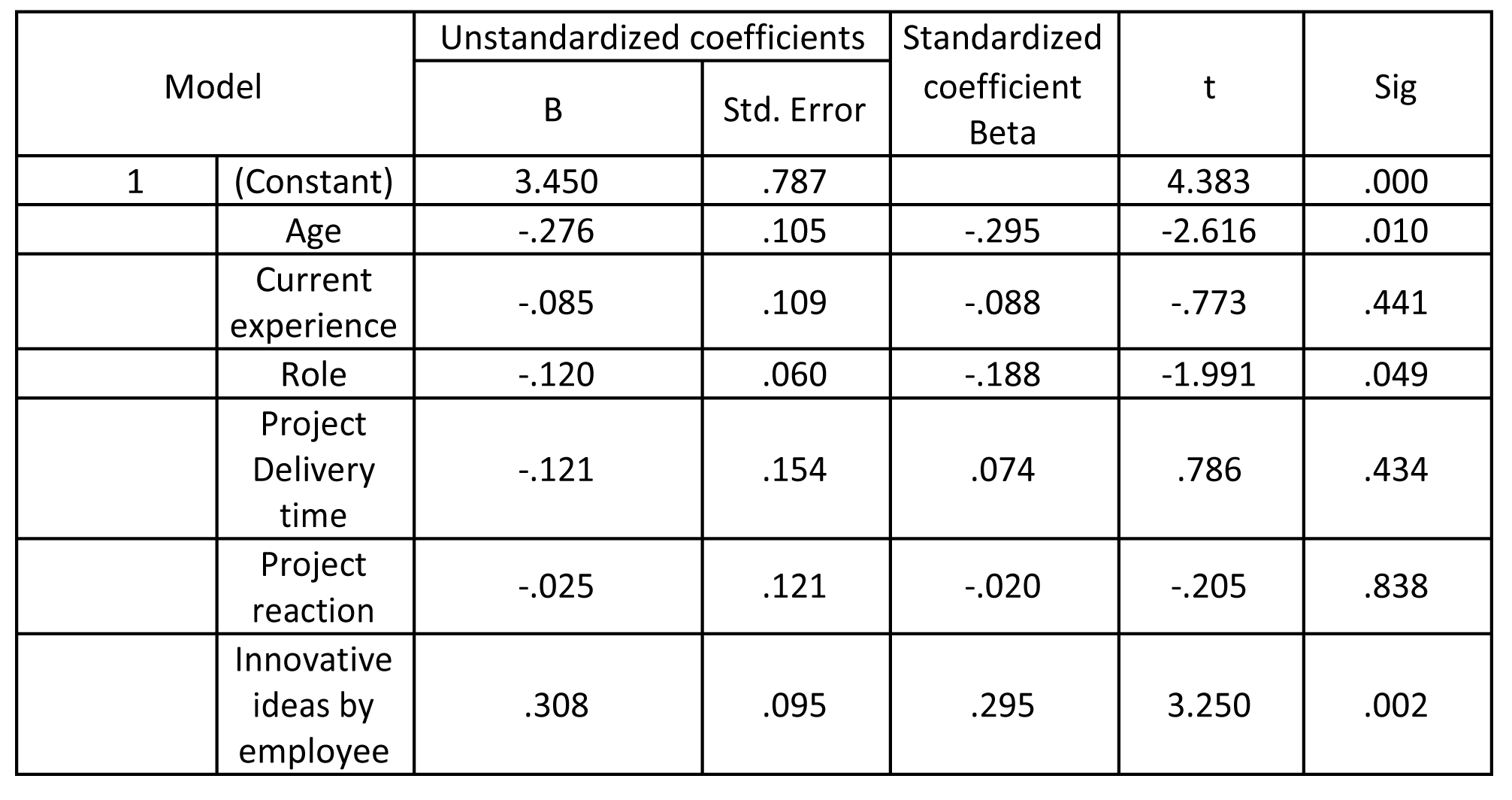
Y -Dependent variable good team environment
From table 3 the equation can be obtained as
Y= 3.450 - 0.276(age) - 0.085(current experience) - 0.12(role) + 0.121(project delivery time) - 0.025(project reaction) + 0.308(innovative ideas by employee).
The independent variables current experience, project delivery time and project reaction are statically significant as their p value is greater than 0.1
. 5.2 Forward regression analysis
Table 4 Descriptive Statistics
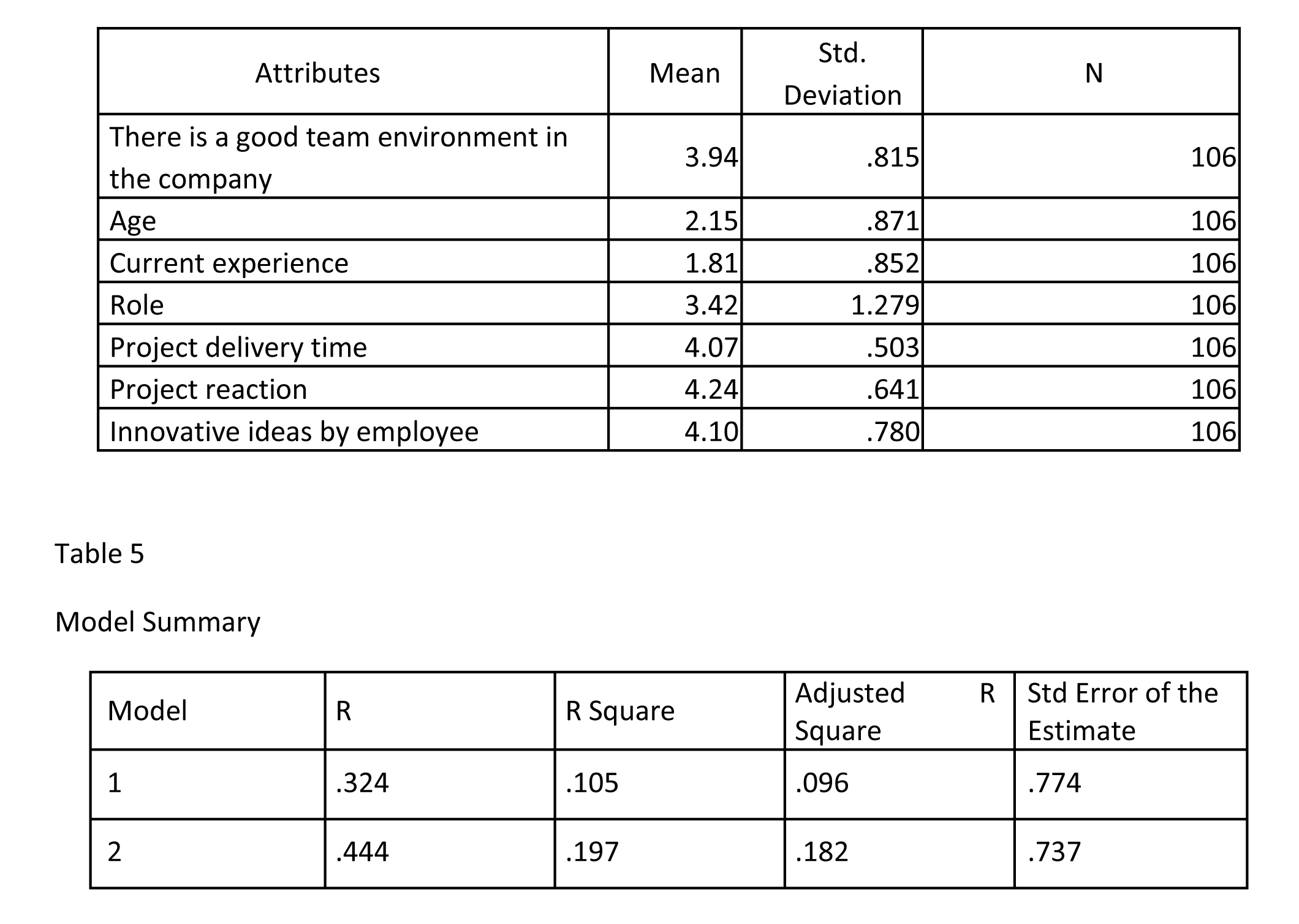
From table 8 the R2 value is 0.44 from which it is understood that 44.4% variance in the occurrence of good team environment by the two independent variables age and innovative ideas by the employee.
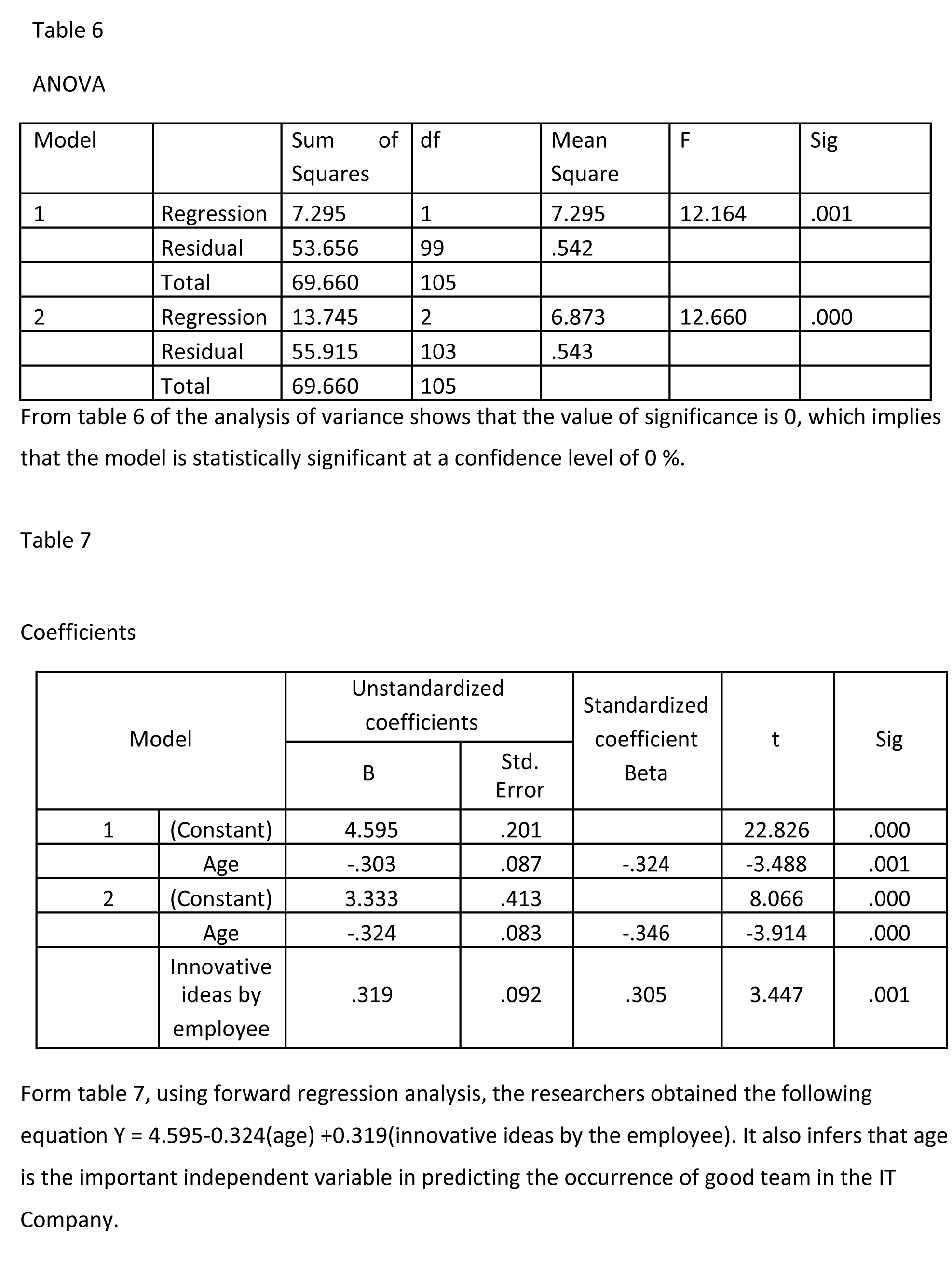
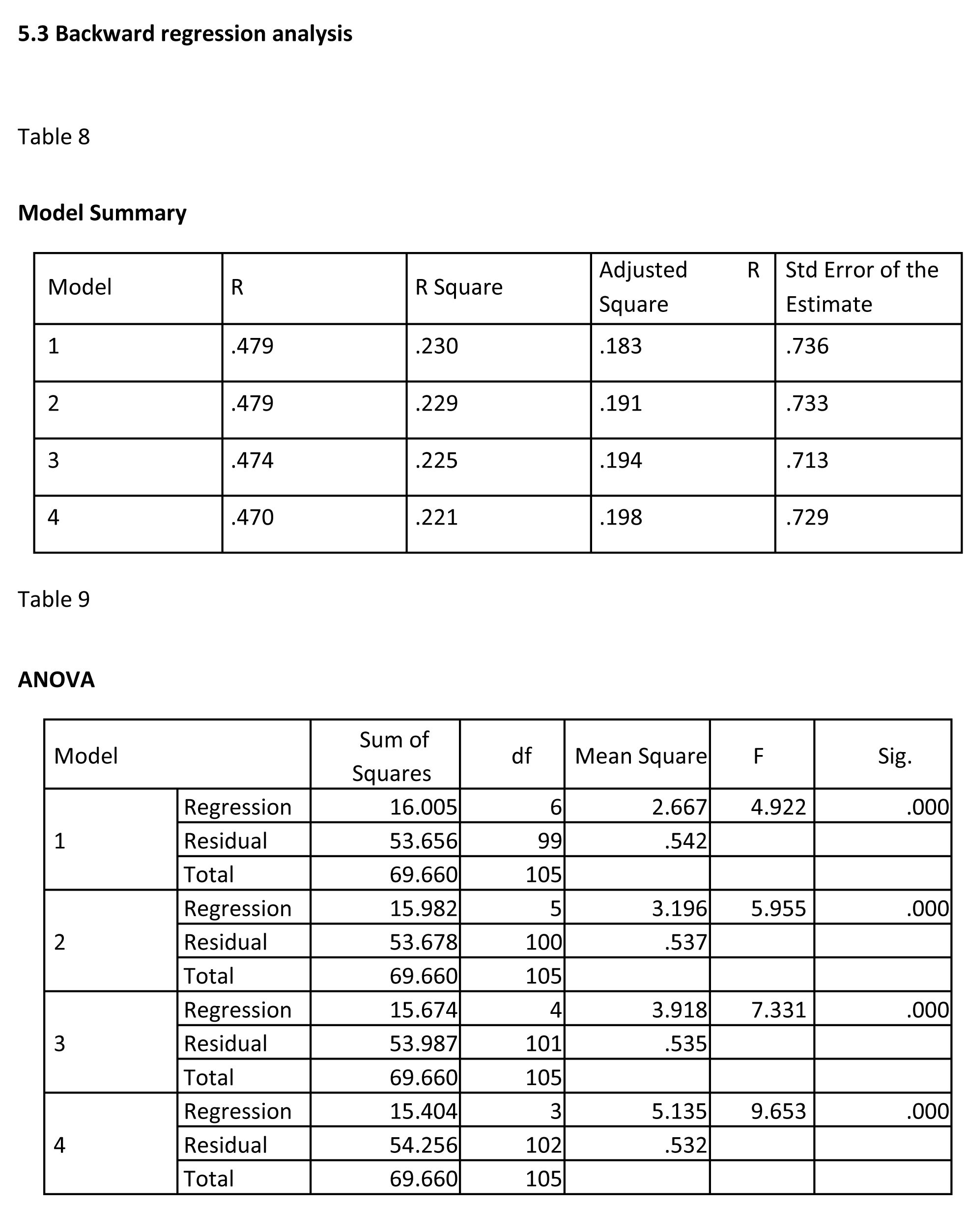
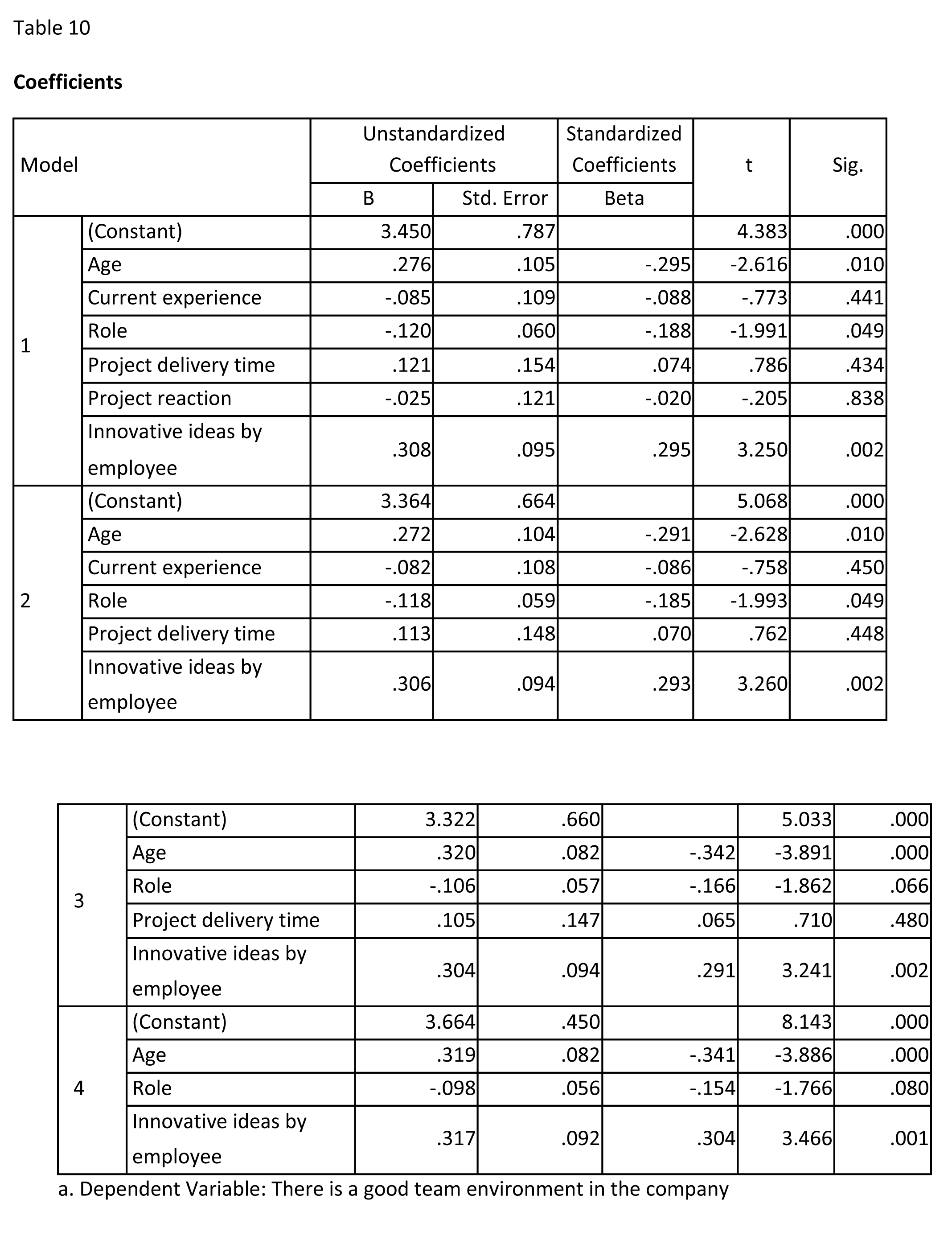
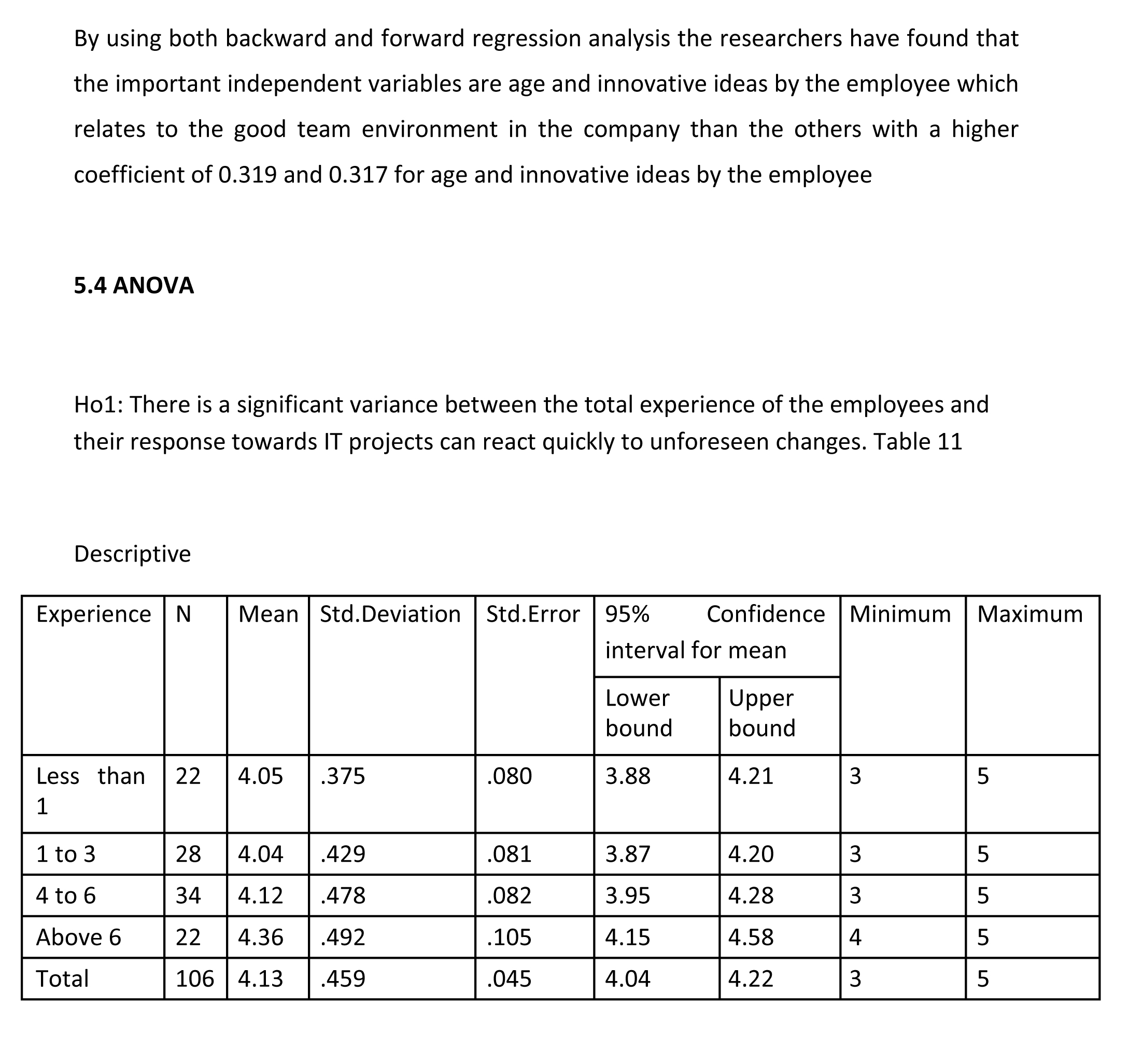
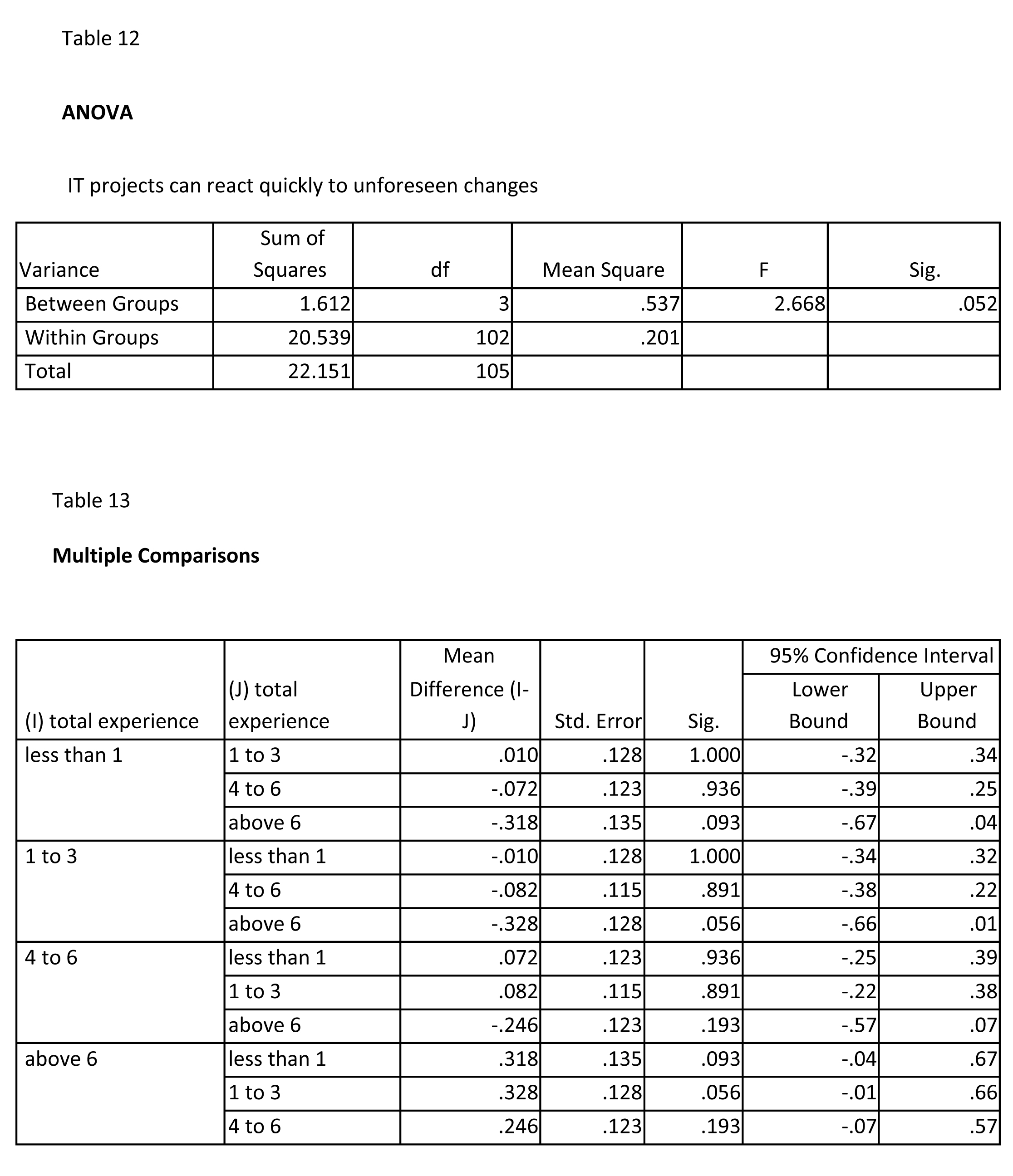
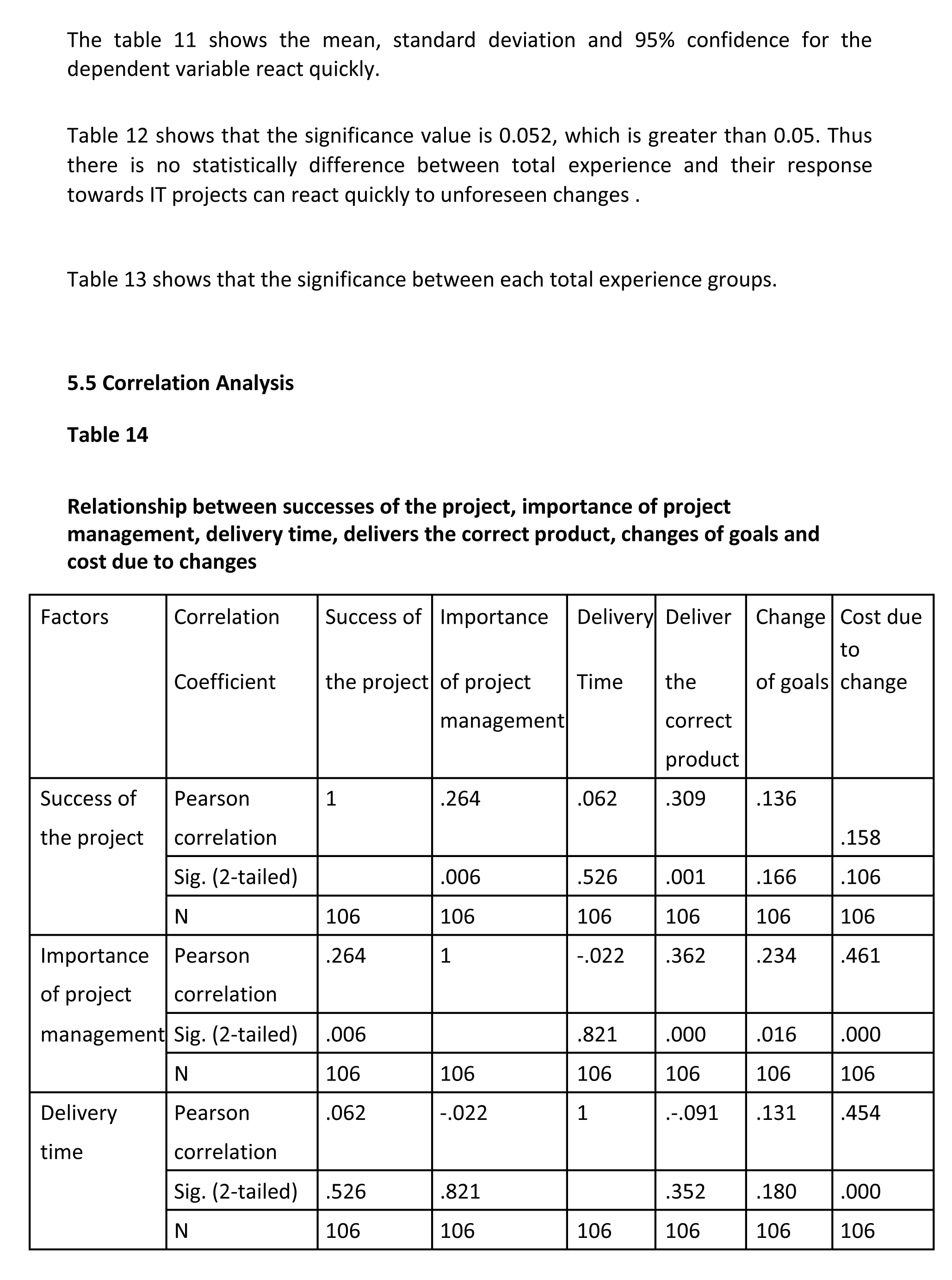

6. Findings and suggestions
Having a clear knowledge about project management techniques does not apply to every employee of the company. The experience of the employee has a greater impact on the maintaining and creating good team environment. There is a high correlation between importance of project management and cost due to change. Employees with an experience higher than 4 years have been found to be good at reacting to quick change in the projects that occur frequently. Agile project management is adaptable, but cannot resolve all difficulties. To achieve a good team environment there must be employees of a certain experience in the field present in the team to lead them; the team without an experienced lead will not be quite good at achieving the goal. Employee must be given the freedom to work in an innovative manner rather than a standardized framework, to achieve a good established environment in industry. Projects happening in an SME face some quite exclusive challenges, so the employees must be trained well to adapt to such challenges. Having a great knowledge on project management is not enough for the employees to gain success in projects. To minimize the risk that occurs while handling unstable projects a team must consist of members who are experienced and has high level of project management knowledge. The risk in following a hybrid model is that it leads to many and frequent changes of the requirements at each phases of the project, this could be minimized by maintaining a stable work procedure to be followed.
REFERENCES
- Andersson, S & Tell, J 2009, 'The relationship between the manager and growth in small firms', Journal of Small Business and Enterprise Development, vol. 16, no. 4, pp. 586-98.
- Augustine, S, Payne, B, Sencindiver, F & Woodcook, S 2005, 'Agile project management: steering from the edges', Communications of the ACM, vol. 48, no. 12, pp. 85-9.
- Beck, K 2000, Extreme Programming explained, Addison-Wesley, Upper Saddle River, New Jersey.
- Boehm, BW 1988, 'A spiral model of software development and enhancement', Computer, vol. 21, no. 5, pp. 61-72.
- Boehm, BW & Turner, R 2003, Balancing agility and discipline: a guide for the perplexed, Addison-Wesley Professional, Boston, Massachusetts.
- Chell, E 2008, The entrepreneurial personality: a social construction, 2nd edn., Routledge, London.
- Chertok, BE 2010, Rockets and people, volume III: hot days of the cold war, The NASA History Series, ed. Asif Siddiqi, Vol. 3, US National Aeronautics and Space Admin, Washington, DC.
- Chin, GL 2003, Agile project management: how to succeed in the face of changing project requirements, AMACOM, New York, p. 224.
- Clark, W 1923, The Gantt chart: a working tool of management, The Ronald Press Company, New York.
- Hofstede, G 2001, Culture's consequences: comparing values, behaviors, institutions, and organizations across nations, 2nd edn., Sage Publications, Inc., Thousand Oaks, California.
- Kloppenborg, TJ & Opfer, WA 2002, 'The current state of project management research: trends, interpretations, and predictions', Project Management Journal, vol. 33, no. 2, pp. 5-18
- Kwak, YH & Aanbari, FT 2008, Impact on project management of allied disciplines, Project Management Institute, Inc., Newtown Square, Pennsylania, p. 170.
- Kwak, YH 2005, 'Brief history of project management', in Elias G Carayannis, Young Hoon Kwak and Frank T Anbari (eds), The story of managing projects: an interdisciplinary approach, Praeger Publishers, Westport, Connecticut, pp. 1-9.
- Larman, C & Vodde, B 2010, Practices for scaling lean & agile development: large, multisite, and offshore product development with large-scale Scrum, Addison- Wesley, Westford, Massachusetts.
- Leffingwell, D & Widrig, D 2003, Managing software requirements: a use case approach, 2nd edn., Addison-Wesley, Boston, Massachusetts.
- Morris, PWG 1994, The management of projects, Thomas Telford Services Ltd, London.
- Ogunnaike, BA & Ray, WH 1994, Process dynamics, modeling, and control, Oxford University Press, New York.
- Schwaber, K 2004, Agile project management with Scrum, Microsoft Press, Redmond, Washington.
- Stretton, A 2007, 'A short history of modern project management', PM World Today, vol. IX, no. X, pp. 1-18
- Tahir, PR, Mohamad, MR & Hasan, DuB 2011, 'A short review of factors leading to success of small medium enterprises', Interdisciplinary Journal of Contemporary Research In Business, vol. 2, no. 11, pp. 519-29.
- Thomas, J & Mullaly, M 2008, Researching the value of project management, Project Management Institute, Inc., Newtown Square, Pennsylvania, p. 464.
